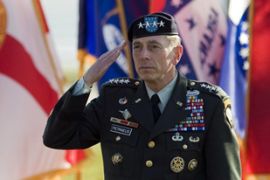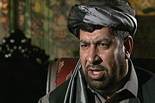Surge ‘no solution in Afghanistan’
US commander says mass influx of troops would not restore security to the country.

Last month, Barack Obama, the US president, ordered 17,000 more US troops to be sent to bolster the 38,000 already in Afghanistan. Ground commanders have reportedly requested that the US force be increased to 60,000 troops.
Petraeus blamed the continuing problems on a “syndicate of extremists,” financing from the drug trade, safe havens in Pakistan and frustration with the slow development of the country’s fledgling government.
Worsening violence
Petraeus’s remarks reflect widespread concerns that the situation in Afghanistan is worsening as anti-government fighters gain strength in many areas of the country and violence reaches its highest levels since the US-led invasion of 2001.
A United Nations report published on Friday said that security had deteriorated and could continue to worsen over the coming months.
“The government, security forces and population of Afghanistan, along with its international partners, face a critical test in 2009,” it said.
“Security has continued to deteriorate. The results of government and international aid efforts have fallen short of popular expectations as Afghans suffer the effects of drought and a global rise in food prices.”
However, Ban Ki-moon, the UN secretary-general, said that extra troops to help train Afghanistan’s security forces and provide protection for election scheduled for August could help the situation.
“A judicious deployment of additional international troops, with its primary goal being the security of the Afghan people,will be a welcome development,” he said.
Civilian deaths
The UN report also identified the rise in civilian deaths as a major problem.
| Major military deployments in Afghanistan |
|
|
The number of civilians killed rose 40 per cent last year to 2,118. Most of the deaths were caused by anti-government fighters, but 39 per cent were caused by international and Afghan government forces.
On Saturday, at least five people were killed in a military operation by US and Afghan troops in Logar province, south of the capital, Kabul.
The US military said that suspected fighters were shot after opening fire on the troops, but a spokesman for the provincial governor said a government delegation had confirmed the dead were civilians.
Angry villagers held a protest near a government compound later in the day and police opened fire on them to prevent them from storming the building, Den Mohammad Darwesh, the governor’s spokesman, said.
The US military said that the raid had targeted the leader of a group making roadside bombs.
“They were five armed militants that fired on a joint force … when they went in to get a targeted individual,” Colonel Greg Julian, a US military spokesman, said.
After angry condemnations by Hamid Karzai, the president, following civilian deaths in US and Nato-led operations, Washington recently agreed to put Afghan forces on all of its missions.


 US: 55,000 (north and east)
US: 55,000 (north and east)